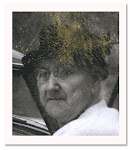The third image from the vintage snapshots of Hawaii I recently found, the Moana Hotel. I find it fascinating how empty it appears. One lone person standing in front of it. No cars. No tourists. No life. A grand building with nothing particularly grand going on.

Click on image to see it larger.
Today the large park like lawn is gone, replaced by busy Kalakaua Avenue. Try to imagine a hotel like this being built today. Instead of spreading out they all go up and up and...look down on the hotels from long ago. Click here to see an old image of the beach side.
The Moana Hotel, also known as the First Lady of Waikīkī, is a famous historic hotel on the island of Oʻahu, located at 2365 Kalākaua Avenue in Honolulu, Hawaiʻi. It is today one of three buildings that make up the Moana Surfrider, A Westin Resort & Spa. Built in the late 19th century as the first hotel in Waikiki, the Moana opened its doors to guests in 1901, becoming the first large hotel in Waikīkī. The Moana Hotel is regarded as the flagship in Hawaiʻi tourism, and has been listed on the National Register of Historic Places. In Hawaiian, moana means "open sea" or "ocean."
The wealthy Honolulu landowner, Walter Chamberlain Peacock, in an effort to establish a fine resort in the previously neglected Waikiki area of Honolulu, incorporated the Moana Hotel Company in 1896. Working with a design by architect Oliver G. Traphagen and $150,000 in capital, The Lucas Brothers contractors completed the structure in 1901. Construction of The Moana marked the beginning of tourism in Waikiki, becoming the first hotel amidst the bungalows and beach houses.
The Moana's architecture was influenced by European styles popular at the time, with Ionic columns and intricate woodwork and plaster detailing throughout the building. The Moana was designed with a grand porte cochere on the street side and wide lānais on the ocean side. Some of the 75 guest rooms had telephones and bathrooms (unusual at the time), and the hotel featured a billiard room, saloon, main parlor, reception area, and library. Peacock installed the first electric-powered elevator in the islands at the Moana, which is still in use today.
Design features of the original structure that survive to this day include extra-wide hallways (to accommodate steamer trunks), high ceilings, and cross-ventilation windows (to cool the rooms prior to air conditioning).
The Moana officially opened on March 11, 1901. Its first guests were a group of Shriners, who paid $1.50 per night for their rooms. Peacock did not find success with his endeavor, and sold the hotel to Alexander Young, a prominent businessman with other hotel holdings. The Young estate operated the hotel until the Matson Navigation Company bought the property in 1932 for $1.6 million.
Over the course of Matson's ownership of the Moana, it grew along with the popularity of Hawaiian tourism. Two floors were added in 1928 along with Italian Renaissance-styled concrete wings on each side of the hotel, creating its H shape seen today.
The hotel's outward appearance was altered slightly over the years, including "updates" to such designs as Art Deco in the 30's and Bauhaus in the 50's.
From 1935 to 1975, the Moana's courtyard hosted the Hawaii Calls live radio broadcast. Legend has it that listeners mistook the hiss of the radio transmission as the waves breaking on the beach. When learning of this, the host instructed the soundman to run down to the waterfront to actually record the sound, which became a staple of the show. (SOURCE: Wikipedia)

















No comments:
Post a Comment